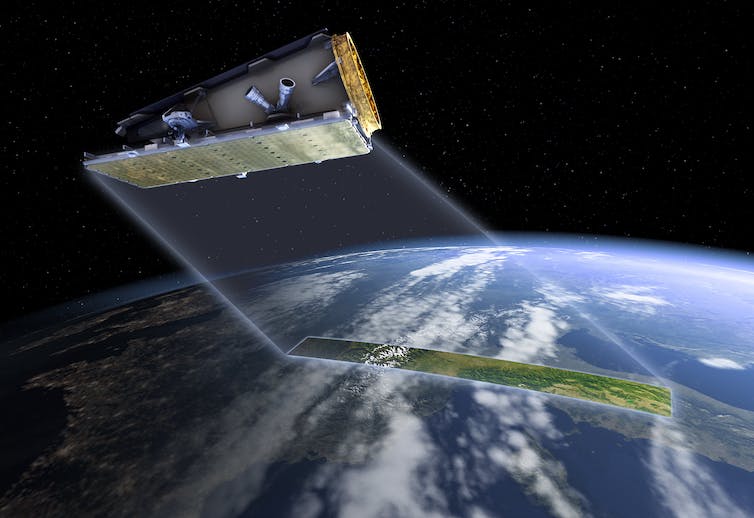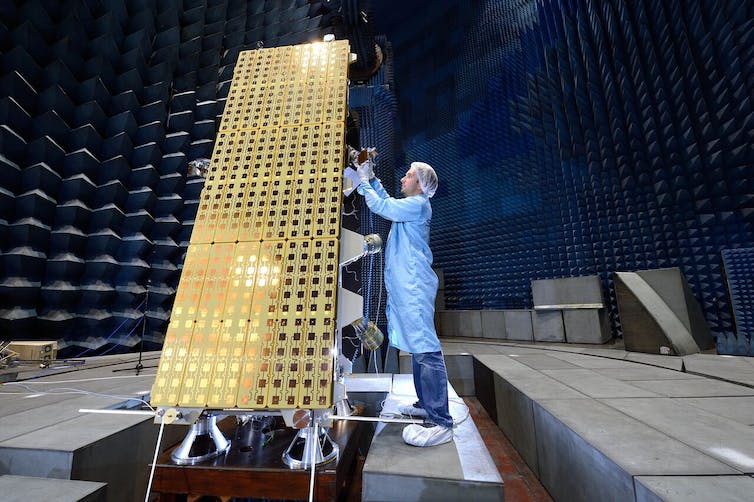
Australia – for the first time - will soon have the power to task an Earth imaging satellite in orbit. We’ll be able to collect imagery where we need it, and downlink the data directly into Australian ground stations.
CSIRO, under an agreement with Surrey Satellite Technology Limited (SSTL), has secured a 10% share of “tasking and acquisition” time on the NovaSAR satellite, due for launch later this year.
For the next seven years, Australia will have priority in directing the satellite to collect imagery every time it passes over our region. We will also be able to downlink the data for our own use, to an Australian receiving station, and share it with our research partners.
This will be a valuable asset for Australian scientists. We will learn how best to operate such a space capability to our own advantage, plus we will develop new time-critical downstream uses for the data. These include supporting large-scale disaster response efforts, and other major events where fast access to data is vital for effective decision-making.
NovaSAR will be operated in parallel with CSIRO’s other national facilities, such as the RV Investigator marine research vessel and the Australia Telescope National Facility – but in space.
All-seeing satellite
NovaSAR is a brand new satellite. It can image Earth in all weather conditions, both day and night, using S-Band Synthetic Aperture Radar (or SAR), providing high quality radar images of Earth of between 6m to 30m spatial resolution.
This dual capability is especially useful for land, coastal and marine mapping applications in cloudy tropical areas. It provides us with the ability to track the presence and movement of shipping in our regional waters.

Radar was invented in the mid-20th century. While initially restricted to the military, it’s now applied for many civilian uses.
Circulating Earth at an altitude of about 600km, NovaSAR will generate radio microwaves and measure the strength of their return (that is, how they bounce back from the Earth’s surface). This will enable it to build an image of objects and structures at ground level.
The main advantage of this new initiative is that we can decide where on Earth we want NovaSAR to collect hundreds of thousands of square kilometres of Earth imagery per day, with highest priority for the Australian region. We will send programming instructions to the satellite via a computer terminal based in Australia that is connected to SSTL’s operations centre in the UK.
The satellite will then be tasked to point its radar at our chosen areas, collect this data, then send it directly down to ground receiving stations based in Australia while passing overhead.
It’s all in the analytics
Last year’s report on Australian Government Earth Observation Data Requirements to 2025 found that Australia’s Earth observation data storage requirements are expected to increase dramatically over the next decade. This will support the data needs of more than 140 government programs with a cumulative storage capacity requirement of approximately 44 PetaBytes by 2025.
The Open Data Cube (ODC) platform - developed by Geoscience Australia, CSIRO and the National Computational Infrastructure facility and international partners – will house and process petabytes of satellite Earth observation data from multiple sensors.
The ODC is built from open-source software and is used as the base technology for the new Digital Earth Australia program, plus 20 emerging datacubes around the world, designed to use Earth observation data and analytics more effectively.
Focus on Australia
Earth observation data today is no longer just a research activity. It informs policy, helps manage natural environments, assists recovery from major catastrophes and generates agricultural and industrial development opportunities.
NovaSAR will allow a new level of control over Earth observation data in and for Australia.
![]() With the recent announcement that Australia will develop a space agency, it’s an exciting time to work in the space sector.
With the recent announcement that Australia will develop a space agency, it’s an exciting time to work in the space sector.
Alex Held, Principal Research Scientist, CSIRO
This article was originally published on The Conversation. Read the original article.
